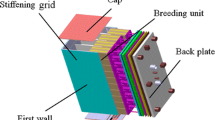Abstract
The China Fusion Engineering Test Reactor (CFETR) is a next step tokamak under designing in China, which should be tritium self-sustained by blanket aimed at getting fusion power of 50–200 MW. One of the most challenging components of CFETR is the actively cooled divertor devoted to controlling the plasma boundary, exhausting the heat and reducing the impurities in the plasma. The thermo-hydraulic and mechanical design of the divertor are particularly demanding because of the high heat loads on the divertor plasma-facing components, the critical heat flux, the pressure drop related to the pumping power and the thermal stresses caused by big temperature gradient. In order to verify the feasibility of the divertor cooling structure, finite element calculations have been carried out. The mass rate of the cooling water should be as high as possible concerning the heat loads bearing of the divertor. But simultaneously the pumping power for the cooling system would be higher. In the paper, an optimal mass rate is given as a compromise between the heat loads bearing and the pumping power based on analysis results.






Similar content being viewed by others
References
W. Yuanxi, Consideration of the Missions of CFETR, CFETR Meeting, Yichang, China (2013)
X. Peng et al., Engineering conceptual design of CFETR divertor. Fusion Eng. Des. (2015). doi:10.1016/j.fusengdes.2015.01.017
M.L. Zhao, Y.P. Chen, H.Y. Guo et al., Modeling of divertor geometry effects in China fusion engineering testing reactor by SOLPS/B2-Eirene. Phys. Plasmas 21(5), 052503 (2014)
M. Richou, M. Missirlian, B. Riccardi et al., Fatigue lifetime of repaired high heat flux components for ITER divertor. Fusion Eng. Des. 86(9), 1771–1775 (2011)
P. Gavila, B. Riccardi, S. Constans et al., High heat flux testing of mock-ups for a full tungsten ITER divertor. Fusion Eng. Des. 86(9), 1652–1655 (2011)
E. Visca, E. Cacciotti, S. Libera et al., Manufacturing and testing of reference samples for the definition of acceptance criteria for the ITER divertor. Fusion Eng. Des. 85(10), 1986–1991 (2010)
R. Tivey, M. Akiba, D. Driemeyer et al., ITER R&D: vacuum vessel and in-vessel components: divertor cassette. Fusion Eng. Des. 55(2), 219–229 (2001)
ITER Structural Design Criteria for In-vessel Components (SDC-IC), (internal project document distributed to the ITER Participants) (2011)
Design and Construction for Mechanical Components of nuclear installations (RCC-MR), AFCEN n 111/2007 (2007)
Règles de conception et de construction des matériels mécaniques desréacteurs expérimentaux de leurs auxiliaires et des dispositifs d’irradiation (RCC-MX), CEA Edition (2008)
Design and Construction Rules for mechanical components of nuclear installations applicable for high temperature structures and ITER vacuum vessel (RCCMRx) (2012)
G. Vieider, Divertor and cooling systems for fusion reactors, STUDSVIK Report, Studsvik Eco & Safety AB, STUDSVIK/ES-01/02 (2001)
A.R. Raffray, R. Nygren, D.G. Whyte et al., High heat flux components—readiness to proceed from near term fusion systems to power plants. Fusion Eng. Des. 85(1), 93–108 (2010)
C.B. Baxi, Thermal hydraulics of water cooled divertors. Fusion Eng. Des. 56, 195–198 (2001)
A.R. Raffray, J. Schlosser, M. Akiba et al., Critical heat flux analysis and R&D for the design of the ITER divertor. Fusion Eng. Des. 45(4), 377–407 (1999)
Summary of material properties for structural analysis of the ITER internal components, ITER_D_23HL7T v.3.2
Acknowledgments
This work is supported by the National Magnetic Confinement Fusion Science Program of China (Grant Nos. 2011GB114003, 2014GB101001 and 2014GB110001) and National Natural Science Foundation of China (Grant No. 11375191).
Author information
Authors and Affiliations
Corresponding author
Rights and permissions
About this article
Cite this article
Chen, P., Ye, M., Peng, X. et al. Preliminary Thermo-hydraulic and Mechanical Analysis for CFETR Divertor. J Fusion Energ 34, 901–904 (2015). https://doi.org/10.1007/s10894-015-9892-9
Published:
Issue Date:
DOI: https://doi.org/10.1007/s10894-015-9892-9




